|
6 -
EVIDENCE FOR ADVANCED CULTURE IN DISTANT AGES
-
Artifacts from
Aix-en-Provence, France
-
Letters in Marble Block,
Philadelphia
-
Nail in Devonian Sandstone,
Scotland
-
Gold Thread in Carboniferous
Stone, England
-
Metallic Vase from
Precambrian Rock at Dorchester, Mass
-
A Tertiary Chalk Ball from Laon,
France
-
Objects from Illinois Well
Boring
-
A Clay Image from Nampa,
Idaho
-
Gold Chain in Carboniferous
Coal from Morrisonville, Illinois
-
Carved Stone from Lehigh
Coal Mine near Webster, Iowa
-
Iron Cup from Oklahoma Coal Mine
-
A Shoe Sole from Nevada
-
Block Wall in an Oklahoma
Mine
-
Metallic Tubes from Chalk in
France
-
Shoe Print in Shale from
Utah
-
Grooved Sphere from South
Africa
Up to this point, most of the evidence we have considered gives the
impression that even if humans did exist in the distant past, they
remained at a somewhat primitive level of cultural and technological
achievement. One might well ask the following question. If humans
had a long time to perfect their skills, then why do we not find
ancient artifacts indicative of an advancing civilization?
In 1863, Charles Lyell expressed this doubt in his book Antiquity of
Man:
"instead of the rudest pottery or flint tools. . . . we should
now be finding sculptured forms, surpassing in beauty the
masterpieces of Phidias or Praxiteles; lines of buried railways or
electric telegraphs, from which the best engineers of our day might
gain invaluable hints; astronomical instruments and microscopes of
more advanced construction than any known in Europe, and other
indications of perfection in the arts and sciences."
The following
reports do not quite measure up to this standard, but some of the
objects described do give hints of unexpected accomplishments.
Not only are some of the objects decidedly more advanced than stone
tools, but many also occur in geological contexts far older than we
have thus far considered.
The reports of this extraordinary evidence emanate, with some
exceptions, from nonscientific sources. And often the artifacts
themselves, not having been preserved in standard natural history
museums, are impossible to locate.
We ourselves are not sure how much importance should be given to
this highly anomalous evidence. But we include it for the sake of
completeness and to encourage further study.
In this chapter, we have included only a sample of the published
material available to us. And given the spotty reporting and
infrequent preservation of these highly anomalous discoveries, it is
likely that the entire body of reports now existing represents only
a small fraction of the total number of such discoveries made over
the past few centuries.
ARTIFACTS FROM AIX-EN-PROVENCE, FRANCE
In his book Mineralogy, Count Bournon recorded an intriguing
discovery that had been made by French workmen in the latter part of
the eighteenth century.
In his description of the details about the
discovery, Bournon wrote:
"During the years 1786, 1787, and 1788,
they were occupied near Aix-en-Provence, in France, in quarrying
stone for the rebuilding, upon a vast scale, of the Palace of
Justice. The stone was a limestone of deep grey, and of that kind
which are tender when they come out of the quarry, but harden by
exposure to the air. The strata were separated from one another by a
bed of sand mixed with clay, more or less calcareous. The first
which were wrought presented no appearance of any foreign bodies,
but, after the workmen had removed the ten first beds, they were
astonished, when taking away the eleventh, to find its inferior
surface, at the depth of forty or fifty feet, covered with shells.
The stone of this bed having been removed, as they were taking away
a stratum of argillaceous sand, which separated the eleventh bed
from the twelfth, they found stumps of columns and fragments of
stone half wrought, and the stone was exactly similar to that of the
quarry: they found moreover coins, handles of hammers, and other
tools or fragments of tools in wood.
But that which principally
commanded their attention, was a board about one inch thick and
seven or eight feet long; it was broken into many pieces, of which
none were missing, and it was possible to join them again one to
another, and to restore to the board or plate its original form,
which was that of the boards of the same kind used by the masons and
quarry men: it was worn in the same manner, rounded and waving upon
the edges."
Count Bournon, continuing his description, stated:
"The stones which
were completely or partly wrought, had not at all changed in their
nature, but the fragments of the board, and the instruments, and
pieces of instruments of wood, had been changed into agate, which
was very fine and agreeably colored. Here then, we have the traces
of a work executed by the hand of man, placed at a depth of fifty
feet, and covered with eleven beds of compact limestone: every thing
tended to prove that this work had been executed upon the spot where
the traces existed. The presence of man had then preceded the
formation of this stone, and that very considerably since he was
already arrived at such a degree of civilization that the arts were
known to him, and that he wrought the stone and formed columns out
of it."
These passages appeared in the American Journal of Science
in 1820; today, however, it is unlikely such a report would be found
in the pages of a scientific journal.
Scientists simply do not take
such discoveries seriously.
LETTERS IN MARBLE BLOCK, PHILADELPHIA
In 1830, letter-like shapes were discovered within a solid block of
marble from a quarry 12 miles northwest of Philadelphia. The marble
block was taken from a depth of 60-70 feet. This was reported in the
American Journal of Science in 1831.
The quarry workers removed
layers of gneiss, mica slate, hornblende, talcose slate, and
primitive clay slate before coming to the layer from which the block
containing the letter-like shapes was cut.
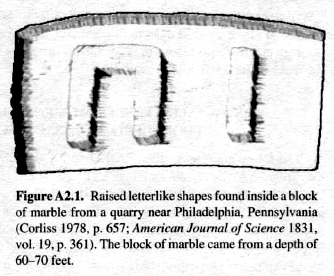
While they were sawing through the block, the workmen happened to
notice a rectangular indentation, about 1.5 inches wide by .625
inches high, displaying two raised characters. Several respectable
gentlemen from nearby Norristown, Pennsylvania, were called to the
scene and inspected the object. It is hard to explain the formation
of the characters as products of natural physical processes.
This
suggests the characters were made by intelligent humans from the
distant past.
NAIL IN DEVONIAN SANDSTONE, SCOTLAND
In 1844, Sir David Brewster reported that a nail had been discovered
firmly embedded in a block of sandstone from the Kingoodie
(Mylnfield) Quarry in Scotland. Dr. A. W. Medd of the British
Geological Survey wrote to us in 1985 that this sandstone is of
"Lower Old Red Sandstone age" (Devonian, between 360 and 408 million
years old). Brewster was a famous Scottish physicist. He was a
founder of the British Association for the Advancement of Science
and made important discoveries in the field of optics.
In his report to the British Association for the Advancement of
Science, Brewster stated:
"The stone in Kingoodie quarry consists of
alternate layers of hard stone and a soft clayey substance called
'till'; the courses of stone vary from six inches to upwards of six
feet in thickness. The particular block in which the nail was found,
was nine inches thick, and in proceeding to clear the rough block
for dressing, the point of the nail was found projecting about half
an inch (quite eaten with rust) into the 'till,' the rest of the
nail lying along the surface of the stone to within an inch of the
head, which went right down into the body of the stone."
The fact
that the head of the nail was buried in the sandstone block would
seem to rule out the possibility the nail had been pounded into the
block after it was quarried.
GOLD THREAD IN CARBONIFEROUS STONE, ENGLAND
On June 22, 1844, this curious report appeared in the London Times:
"A few days ago, as some workmen were employed in quarrying a rock
close to the Tweed about a quarter of a mile below Rutherford-mill,
a gold thread was discovered embedded in the stone at a depth of
eight feet."
Dr. A. W. Medd of the British Geological Survey wrote
to us in 1985 that this stone is of Early Carboniferous age (between
320 and 360 million years old).
METALLIC VASE FROM PRECAMBRIAN ROCK AT DORCHESTER, MASSACHUSETTS
The following report, titled "A Relic of a Bygone Age," appeared in
the magazine Scientific American (June 5, 1852):
"A few days ago a
powerful blast was made in the rock at Meeting House Hill, in
Dorchester, a few rods south of Rev. Mr. Hall's meeting house. The
blast threw out an immense mass of rock, some of the pieces weighing
several tons, and scattered fragments in all directions. Among them
was picked up a metallic vessel in two parts, rent asunder by the
explosion. On putting the two parts together it formed a bell-shaped
vessel, 4-1/2 inches high, 6-1/2 inches at the base, 2-1/2 inches at
the top, and about an eighth of an inch in thickness. The body of
this vessel resembles zinc in color, or a composition metal, in
which there is a considerable portion of silver. On the side there
are six figures or a flower, or bouquet, beautifully inlaid with
pure silver, and around the lower part of the vessel a vine, or
wreath, also inlaid with silver.
The chasing, carving, and inlaying
are exquisitely done by the art of some cunning workman. This
curious and unknown vessel was blown out of the solid pudding stone,
fifteen feet below the surface. It is now in the possession of Mr.
John Kettell. Dr. J. V. C. Smith, who has recently traveled in the
East, and examined hundreds of curious domestic utensils, and has
drawings of them, has never seen anything resembling this. He has
taken a drawing and accurate dimensions of it, to be submitted to
the scientific. There is not doubt but that this curiosity was blown
out of the rock, as above stated; but will Professor Agassiz, or
some other scientific man please to tell us how it came there? The
matter is worthy of investigation, as there is no deception in the
case."
The editors of Scientific American ironically remarked:
"The above
is from the Boston Transcript and the wonder is to us, how the
Transcript can suppose Prof. Agassiz qualified to tell how it got
there any more than John Doyle, the blacksmith. This is not a
question of zoology, botany, or geology, but one relating to an
antique metal vessel perhaps made by Tubal Cain, the first
inhabitant of Dorchester."
According to a recent U.S. Geological Survey map of the
Boston-Dorchester area, the pudding stone, now called the Roxbury
conglomerate, is of Precambrian age, over 600 million years old. By
standard accounts, life was just beginning to form on this planet
during the Precambrian.
But in the Dorchester vessel we have
evidence indicating the presence of artistic metalworkers in North
America over 600 million years before Leif Erikson.
A TERTIARY CHALK BALL FROM LAON, FRANCE
The April 1862 edition of The Geologist included an English
translation of an intriguing report by Maximilien Melleville, the
vice president of the Academic Society of Laon, France.
In his
report, Melleville described a round chalk ball discovered 75 meters
(about 246 feet) below the surface in early Tertiary lignite beds
near Laon.
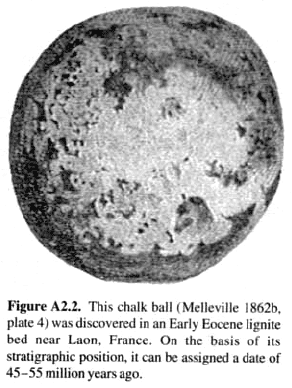
Lignite (sometimes called ash) is a soft brown coal. The lignite
beds at Montaigu, near Laon, lie at the base of a hill and were
mined by horizontal shafts. The main shaft ran 600 meters (about
1,969 feet) into a bed of lignite.
In August of 1861, workmen digging at the far end of the shaft, 225
feet below the surface of the hill, saw a round object fall down
from the top of the excavation. The object was about 6 centimeters
(2.36 inches) in diameter and weighed 310 grams (about 11 ounces).
Melleville stated:
"They looked to see exactly what place in the
strata it had occupied, and they are able to state that it did not
come from the interior of the 'ash,' but that it was imbedded at its
point of contact with the roof of the quarry, where it had left its
impression indented."
The workmen carried the chalk ball to a Dr. Lejeune, who informed Melleville.
Melleville then stated:
"Long before this discovery, the workmen of
the quarry had told me they had many times found pieces of wood
changed into stone. . . . bearing the marks of human work. I regret
greatly now not having asked to see these, but I did not hitherto
believe in the possibility of such a fact."
According to Melleville, there was no possibility that the chalk
ball was a forgery:
"It really is penetrated over four-fifths of its
height by a black bituminous color that merges toward the top into a
yellow circle, and which is evidently due to the contact of the
lignite in which it had been for so long a time plunged. The upper
part, which was in contact with the shell bed, on the contrary has
preserved its natural color—the dull white of the chalk. . . . As to
the rock in which it was found, I can affirm that it is perfectly
virgin, and presents no trace whatever of any ancient exploitation.
The roof of the quarry was equally intact in this place, and one
could see there neither fissure nor any other cavity by which we
might suppose this ball could have dropped down from above."
Regarding human manufacture of the chalk object, Melleville was
cautious. He wrote:
"from one fact, even so well established, I do
not pretend to draw the extreme conclusion that man was contemporary
with the lignites of the Paris basin. . . . My sole object in
writing this notice is to make known a discovery as curious as
strange, whatever may be its bearing, without pretending to any mode
of explanation. I content myself with giving it to science, and I
shall wait before forming an opinion in this respect, for further
discoveries to furnish me with the means of appreciating the value
of this at Montaigu."
Geology's editors wrote:
"We consider his resolution wise in
hesitating to date back the age of man to the lower Tertiary period
of the Paris basin without further confirmatory evidence."
In 1883,
Gabriel de Mortillet suggested that a piece of white chalk was
rolled in the waves of the incoming Tertiary seas and after it
became round was left where it was found.
This does not, however, seem to be a likely explanation. First of
all, the ball had features inconsistent with the action of waves.
Melleville reported:
"Three great splinters with sharp angles,
announce also that it had remained during the working attached to
the block of stone out of which it was made, and that it had been
separated only after it was finished, by a blow, to which this kind
of fracture is due."
If wave action is accepted as the explanation
of the general roundness of the object, this action should also have
smoothed the sharp edges described by Melleville. Furthermore, it is
likely that sustained exposure to waves would have disintegrated a
piece of chalk.
De Mortillet stated that the ball was found in an Early Eocene
stratum. If humans made the ball, they must have been in France
45-55 million years ago. As extraordinary as this might seem to
those attached to the standard evolutionary views, it is in keeping
with the evidence considered in this book.
OBJECTS FROM ILLINOIS WELL BORING
In 1871, William E. Dubois of the Smithsonian Institution reported
on several man-made objects found at deep levels in Illinois. The
first object was a copper quasi-coin from Lawn Ridge, in Marshall
County, Illinois.
In a letter to the Smithsonian Institution, J. W. Moffit stated that in August 1870 he was drilling a well using a
"common ground auger." When Moffit brought the auger up from a depth
of 125 feet, he discovered the coin-like object "on the auger."
To get down to 125 feet, Moffit drilled through the following
strata: 3 feet of soil; 10 feet of yellow clay; 44 feet of blue
clay; 4 feet of clay, sand, and gravel; 19 feet of purple clay; 10
feet of brown hard pan; 8.5 feet of green clay; 2 feet of vegetable
mould; 2.5 feet of yellow clay; 2 feet of yellow hard pan; and 20.5
feet of mixed clay.
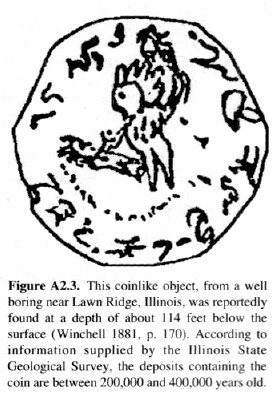
In 1881, A. Winchell also described the coin-like object. Winchell
quoted a letter by W. H. Wilmot, who listed a sequence of strata
slightly different from that given by Moffit. Wilmot reported that
the quasi-coin had been discovered in the well boring at a depth of
114 feet rather than 125 feet.
Using the sequence of strata given by Winchell, the Illinois State
Geological Survey gave us an estimate for the age of the deposits at
the 114-foot level. They would have formed during the Yarmouthian
Interglacial "sometime between 200,000 and 400,000 years ago."
W. E. Dubois said that the shape of the quasi-coin was "polygonal
approaching to circular," and that it had crudely portrayed figures
and inscriptions on both sides. The inscriptions were in a language
that Dubois could not recognize, and the quasi-coin's appearance
differed from any known coin.
Dubois concluded that the coin must have been made in a machine
shop. Noting its uniform thickness, he said the coin must have
"passed through a rolling-mill; and if the ancient Indians had such
a contrivance, it must have been prehistoric."
Furthermore, Dubois
reported that the coin must have been cut with shears or a chisel
and the sharp edges filed down.
The quasi coin described above suggests the existence of a
civilization at least 200,000 years ago in North America. Yet beings
intelligent enough to make and use coins (Homo sapiens sapiens) are
generally not thought to have lived much earlier than 100,000 years
ago. According to standard views, metal coins were first used in
Asia Minor during the eighth century B.C.
Moffit also reported that other artifacts were found in nearby
Whiteside County, Illinois. At a depth of 120 feet, workmen
discovered,
"a large copper ring or ferrule, similar to those used on
ship spars at the present time. . . . They also found something
fashioned like a boat-hook."
Mr. Moffit added:
"There are numerous
instances of relics found at lesser depths. A spear-shaped hatchet,
made of iron, was found imbedded in clay at 40 feet; and stone pipes
and pottery have been unearthed at depths varying from 10 to 50 feet
in many localities."
In September 1984, the Illinois State
Geological Survey wrote to us that the age of deposits at 120 feet
in Whiteside County varies greatly. In some places, one would find
at 120 feet deposits only 50,000 years old, while in other places
one would find Silurian bedrock 410 million years old.
A CLAY IMAGE FROM NAMPA, IDAHO
A small human image, skillfully formed in clay, was found in 1889 at
Nampa, Idaho. The figurine came from the 300-foot level of a well
boring.
In 1912, G. F. Wright wrote:
"The record of the well shows
that in reaching the stratum from which the image was brought up
they had penetrated first about fifty feet of soil, then about
fifteen feet of basalt, and afterwards passed through alternate beds
of clay and quicksand. . . . down to a depth of about three hundred
feet, when the sand pump began to bring up numerous clay balls, some
of them more than two inches in diameter, densely coated with iron
oxide. In the lower portion of this stratum there were evidences of
a buried land surface, over which there had been a slight
accumulation of vegetable mould. It was from this point that the
image in question was brought up at a depth of three hundred and
twenty feet. A few feet farther down, sand rock was reached."
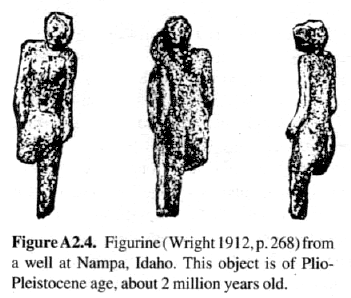
As for the figurine, Wright noted:
"The image in question is made of
the same material as that of the clay balls mentioned, and is about
an inch and a half long; and remarkable for the perfection with
which it represents the human form. . . . It was a female figure,
and had the lifelike lineaments in the parts which were finished
that would do credit to the classic centers of art."
"Upon showing the object to Professor
F. W. Putnam," wrote Wright,
"he at once directed attention to the character of the incrustations
of iron upon the surface as indicative of a relic of considerable
antiquity. There were patches of anhydrous red oxide of iron in
protected places upon it, such as could not have been formed upon
any fraudulent object. In visiting the locality in 1890 I took
special pains, while on the ground, to compare the discoloration of
the oxide upon the image with that upon the clay balls still found
among the debris which has come from the well, and ascertained it to
be as nearly identical as it is possible to be.
These confirmatory
evidences, in connection with the very satisfactory character of the
evidence furnished by the parties who made the discovery, and
confirmed by Mr. G. M. Cumming, of Boston (at that time
superintendent of that division of the Oregon Short Line Railroad,
and who knew all the parties, and was upon the ground a day or two
after the discovery) placed the genuineness of the discovery beyond
reasonable doubt.
To this evidence is to be added, also, the general
conformity of the object to other relics of man which have been
found beneath the lava deposits on the Pacific coast. In comparing
the figurine one cannot help being struck with its resemblance to
numerous 'Aurignacian figurines' found in prehistoric caverns in
France, Belgium, and Moravia. Especially is the resemblance striking
to that of 'The Venus impudica' from Laugerie-Basse."
The Nampa
image is also similar to the famous Willendorf Venus, thought to be
about 30,000 years old.
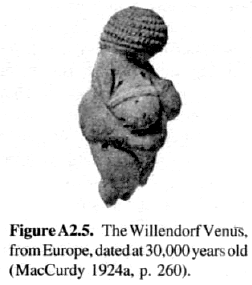
Wright also examined the borehole to see if the figurine could have
slipped down from a higher level.
He stated:
"To answer objections
it will be well to give the facts more fully. The well was six
inches in diameter and was tubed with heavy iron tubing, which was
driven down, from the top, and screwed together, section by section,
as progress was made. Thus it was impossible for anything to work in
from the sides. The drill was not used after penetrating the lava
deposit near the surface, but the tube was driven down, and the
included material brought out from time to time by use of a sand
pump."
Responding to our inquiries, the United States Geological Survey
stated in a letter that the clay layer at a depth of over 300 feet
is "probably of the Glenns Ferry Formation, upper Idaho Group, which
is generally considered to be of Plio-Pleistocene age." The basalt
above the Glenns Ferry formation is considered Middle Pleistocene.
Other than Homo sapiens sapiens, no hominid is known to have
fashioned works of art like the Nampa figurine. The evidence
therefore suggests that humans of the modern type were living in
America around 2 million years ago, at the Plio-Pleistocene
boundary.
That the Nampa figurine strongly challenges the evolutionary
scenario was noted by W. H. Holmes of the Smithsonian Institution.
In 1919, Holmes wrote in his Handbook of Aboriginal American
Antiquities:
"According to Emmons, the formation in which the pump
was operating is of late Tertiary or early Quaternary age; and the
apparent improbability of the occurrence of a well-modeled human
figure in deposits of such great antiquity has led to grave doubt
about its authenticity. It is interesting to note that the age of
this object, supposing it to be authentic, corresponds with that of
the incipient man whose bones were, in 1892, recovered by Dubois
from the late Tertiary or early Quaternary formations of Java."
Here we find the Java man discovery, itself questionable, once more
being used to dismiss evidence for humans of modern abilities in
very ancient times. The evolutionary hypothesis was apparently so
privileged that any evidence contradicting it could be almost
automatically rejected. But although Holmes doubted that beings
capable of making the Nampa image could have existed at the same
time as the primitive Java ape-man, we find today that humans, of
various levels of technological expertise, coexist in Africa with
gorillas and chimpanzees.
Holmes went on to say:
"Like the auriferous gravel finds of
California, if taken at its face value the specimen establishes an
antiquity for Neolithic culture in America so great that we hesitate
to accept it without further confirmation. While it may have been
brought up as reported, there remains the possibility that it was
not an original inclusion under the lava. It is not impossible that
an object of this character could have descended from the surface
through some crevice or water course penetrating the lava beds and
have been carried through deposits of creeping quicksand aided by
underground waters to the spot tapped by the drill."
It is
instructive to note how far a scientist like Holmes will go to
explain away evidence he does not favor. One should keep in mind,
however, that any evidence, including evidence currently used to
buttress the theory of evolution, could be explained away in this
fashion.
A barrier to the supposition that the Nampa image was recently
manufactured by recent Indians and somehow worked its way down from
the surface may be found in this statement by Holmes:
"It should be
remarked, however, that forms of art closely analogous to this
figure are far to seek, neither the Pacific slope on the west nor
the Pueblo region on the south furnishing modeled images of the
human figure of like character or of equal artistic merit."
GOLD CHAIN IN CARBONIFEROUS COAL FROM MORRISONVILLE, ILLINOIS
On June 11, 1891, The Morrisonville Times reported:
"A curious find
was brought to light by Mrs. S. W. Gulp last Tuesday morning. As she
was breaking a lump of coal preparatory to putting it in the
scuttle, she discovered, as the lump fell apart, embedded in a
circular shape a small gold chain about ten inches in length of
antique and quaint workmanship. At first Mrs. Gulp thought the chain
had been dropped accidentally in the coal, but as she undertook to
lift the chain up, the idea of its having been recently dropped was
at once made fallacious, for as the lump of coal broke it separated
almost in the middle, and the circular position of the chain placed
the two ends near to each other, and as the lump separated, the
middle of the chain became loosened while each end remained fastened
to the coal.
This is a study for the students of archaeology who
love to puzzle their brains over the geological construction of the
earth from whose ancient depth the curious is always dropping out.
The lump of coal from which this chain was taken is supposed to come
from the Taylorville or Pana mines [southern Illinois] and almost
hushes one's breath with mystery when it is thought for how many
long ages the earth has been forming strata after strata which hid
the golden links from view. The chain was an eight-carat gold and
weighed eight penny-weights."
In a letter to Ron Calais, Mrs.
Vernon W. Lauer, recently the
publisher of The Morrisonville Times, stated:
"Mr. Gulp was editor
and publisher of the Times in 1891. Mrs. Gulp, who made the
discovery, moved to Taylorville after his death—remarried and her
death occurred on February 3, 1959."
Calais told our research
assistant (Stephen Bernath) that he had information the chain was
given to one of Mrs. Gulp's relatives after her death, but Calais
could not trace the chain further.
The Illinois State Geological Survey has said the coal in which the
gold chain was found is 260-320 million years old. This raises the
possibility that culturally advanced human beings were present in
North America during that time.
CARVED STONE FROM LEHIGH COAL MINE NEAR WEBSTER, IOWA
The April 2, 1897 edition of the Daily News of Omaha, Nebraska,
carried an article titled "Carved Stone Buried in a Mine," which
described an object from a mine near Webster City, Iowa.
The article
stated:
"While mining coal today in the Lehigh coal mine, at a depth
of 130 feet, one of the miners came upon a piece of rock which
puzzles him and he was unable to account for its presence at the
bottom of the coal mine. The stone is of a dark grey color and about
two feet long, one foot wide and four inches in thickness. Over the
surface of the stone, which is very hard, lines are drawn at angles
forming perfect diamonds. The center of each diamond is a fairly
good face of an old man having a peculiar indentation in the
forehead that appears in each of the pictures, all of them being
remarkably alike.
Of the faces, all but two are looking to the right. How the stone
reached its position under the strata of sandstone at a depth of 130
feet is a question the miners are not attempting to answer. Where
the stone was found the miners are sure the earth had never before
been disturbed."
Inquiries to the Iowa State Historical Preservation
and Office of State Archaeology at the University of Iowa revealed
nothing new.
The Lehigh coal is probably from the Carboniferous.
IRON CUP FROM OKLAHOMA COAL MINE
On January 10, 1949, Robert Nordling sent a photograph of an iron
cup to Frank L. Marsh of Andrews University, in Berrien Springs,
Michigan.
Nordling wrote:
"I visited a friend's museum in southern
Missouri. Among his curios, he had the iron cup pictured on the
enclosed snapshot."
At the private museum, the iron cup had been displayed along with
the following affidavit, made by Frank J. Kenwood in Sulphur
Springs, Arkansas, on November 27, 1948:
"While I was working in the
Municipal Electric Plant in Thomas, Okla. in 1912, I came upon a
solid chunk of coal which was too large to use. I broke it with a
sledge hammer. This iron pot fell from the center, leaving the
impression or mould of the pot in the piece of coal. Jim Stall (an
employee of the company) witnessed the breaking of the coal, and saw
the pot fall out. I traced the source of the coal, and found that it
came from the Wilburton, Oklahoma, Mines."
According to Robert O.
Fay of the Oklahoma Geological Survey, the Wilburton mine coal is
about 312 million years old. In 1966, Marsh sent the photo of the
cup and the correspondence relating to it to Wilbert H. Rusch, a
professor of biology at Concordia College, in Ann Arbor, Michigan.
Marsh stated:
"Enclosed is the letter and snap sent me by Robert Nordling some 17 years ago. When I got interested enough in this
'pot' (the size of which can be gotten at somewhat by comparing it
with the seat of the straight chair it is resting on) a year or two
later I learned that this 'friend' of Nordling's had died and his
little museum was scattered. Nordling knew nothing of the
whereabouts of the iron cup. It would challenge the most alert
sleuth to see if he could run it down. . . . If this cup is what it
is sworn to be, it is truly a most significant artifact."
It is an
unfortunate fact that evidence such as this iron cup tends to get
lost as it passes from hand to hand among people not fully aware of
its significance.
A SHOE SOLE FROM NEVADA
On October 8, 1922, the American Weekly section of the New York
Sunday American ran a prominent feature titled "Mystery of the
Petrified 'Shoe Sole' 5,000,000 Years Old," by Dr. W. H. Ballou.
Ballou wrote:
"Some time ago, while he was prospecting for fossils
in Nevada, John T. Reid, a distinguished mining engineer and
geologist, stopped suddenly and looked down in utter bewilderment
and amazement at a rock near his feet. For there, a part of the rock
itself, was what seemed to be a human footprint! Closer inspection
showed that it was not a mark of a naked foot, but was, apparently,
a shoe sole which had been turned into stone. The forepart was
missing.
But there was the outline of at least two-thirds of it, and
around this outline ran a well-defined sewn thread which had, it
appeared, attached the welt to the sole. Further on was another line
of sewing, and in the center, where the foot would have rested had
the object been really a shoe sole, there was an indentation,
exactly such as would have been made by the bone of the heel rubbing
upon and wearing down the material of which the sole had been made.
Thus was found a fossil which is the foremost mystery of science
today. For the rock in which it was found is at least 5,000,000
years old."
Reid brought the specimen to New York, where he tried to bring it to
the attention of other scientists.
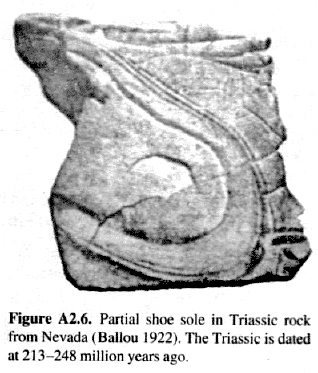
Reid reported:
"On arrival at New
York, I showed this fossil to Dr. James F. Kemp, geologist of
Columbia University; Professors H. F. Osborn, D. Matthew and E. O. Hovey of the American Museum of Natural History. All of these men
reached the same conclusion, in effect that 'it was the most
remarkable natural imitation of an artificial object they had ever
seen.'
These experts agreed, however, that the rock formation was
Triassic, and manufacturers of shoes agreed that originally the
specimen was a hand-welted sole. Dr. W. D. Matthew wrote a brief
report on the find declaring that while all the semblances of a shoe
were present, including the threads with which it had been sewn, it
was only a remarkable imitation, a lusus naturae, or 'freak of
nature.'"
Curiously enough, an inquiry by us to the American Museum
of Natural History resulted in a reply that the report by Matthew is
not in their files.
Reid, despite Matthew's dismissal, nevertheless persisted:
"I next
got hold of a microphotographer and an analytical chemist of the
Rockefeller Institute, who, on the outside, so as not to make it an
institute matter, made photos and analyses of the specimen. The
analyses proved up [removed] any doubt of the shoe sole having been
subjected to Triassic fossilization. . . . The microphoto
magnifications are twenty times larger than the specimen itself,
showing the minutest detail of thread twist and warp, proving
conclusively that the shoe sole is not a resemblance, but is
strictly the handiwork of man.
Even to the naked eye the threads can
be seen distinctly, and the definitely symmetrical outlines of the
shoe sole. Inside this rim and running parallel to it is a line
which appears to be regularly perforated as if for stitches. I may
add that at least two geologists whose names will develop someday
have admitted that the shoe sole is valid, a genuine fossilization
in Triassic rocks."
The Triassic rock bearing the fossil shoe sole
is now recognized as being far more than 5 million years old. The
Triassic period is now generally dated at 213-248 million years ago.
BLOCK WALL IN AN OKLAHOMA MINE
W. W. McCormick of Abilene, Texas, reported his grandfather's
account of a stone block wall that was found deep within a coal
mine:
"In the year 1928, I, Atlas Almon Mathis, was working in coal
mine No. 5., located two miles north of Heavener, Oklahoma. This was
a shaft mine, and they told us it was two miles deep. The mine was
so deep that they let us down into it on an elevator. . . . They
pumped air down to us, it was so deep."
This report was reprinted in
a book by Brad Steiger. One evening, Mathis was blasting coal loose
by explosives in "room 24" of this mine.
"The next morning," said
Mathis, "there were several concrete blocks laying in the room.
These blocks were 12-inch cubes and were so smooth and polished on
the outside that all six sides could serve as mirrors. Yet they were
full of gravel, because I chipped one of them open with my pick, and
it was plain concrete inside."
Mathis added:
"As I started to timber
the room up, it caved in; and I barely escaped. When I came back
after the cave-in, a solid wall of these polished blocks was left
exposed. About 100 to 150 yards farther down our air core, another
miner struck this same wall, or one very similar."
The coal in the
mine was probably Carboniferous, which would mean the wall was at
least 286 million years old.
According to Mathis, the mining company officers immediately pulled
the men out of the mine and forbade them to speak about what they
had seen. This mine was closed in the fall of 1928, and the crew
went to mine number 24, near Wilburton, Oklahoma.
Mathis said the Wilburton miners told of finding "a solid block of
silver in the shape of a barrel. . . . with the prints of the staves
on it." The coal from Wilburton was formed between 280 and 320
million years ago.
Admittedly, these are very bizarre stories, accompanied by very
little in the way of proof. But such stories are told, and we wonder
how many of them there are and if any of them are true.
In a book by M. K. Jessup, we recently ran across the following
wall-in-coal-mine story:
"It is. . . . reported that James Parsons,
and his two sons, exhumed a slate wall in a coal mine at Hammondville, Ohio, in 1868. It was a large, smooth wall, disclosed
when a great mass of coal fell away from it, and on its surface,
carved in bold relief, were several lines of hieroglyphics."
Of
course, such stories could be tall tales, but they might also be
leads for interesting research.
The foregoing sampling of discoveries indicating a relatively high
level of civilization in very distant ages was compiled from reports
published in the nineteenth and early twentieth centuries, but
similar reports continue up to the present day. We shall now review
some of them.
METALLIC TUBES FROM CHALK IN FRANCE
Y. Druet and H. Salfati announced in 1968 the discovery of
semi-ovoid metallic tubes of identical shape but varying size in
Cretaceous chalk. The chalk bed, exposed in a quarry at Saint-Jean
de Livet, France, is estimated to be least 65 million years old.
Having considered and eliminated several hypotheses, Druet and
Salfati concluded that intelligent beings had lived 65 million years
ago.
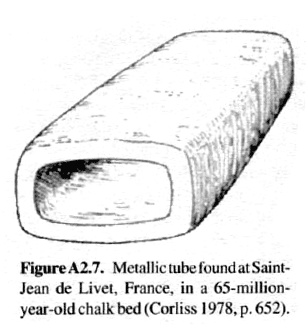
Desiring more information, we wrote to the geomorphology laboratory
at the University of Caen, to which Druet and Salfati reportedly
turned over their specimens, but we have not received a reply.
We
invite readers to communicate to us any information they might have
about this case or similar cases, for inclusion in future editions
of this book.
SHOE PRINT IN SHALE FROM UTAH
In 1968, William J. Meister, a draftsman and amateur trilobite
collector, reported finding a shoe print in the Wheeler Shale near
Antelope Spring, Utah. This shoe-like indentation and its cast were
revealed when Meister split open a block of shale. Clearly visible
within the imprint were the remains of trilobites, extinct marine
arthropods. The shale holding the print and the trilobite fossils is
from the Cambrian, and would thus be 505 to 590 million years old.
Meister described the ancient shoe-like impression in an article
that appeared in the Creation Research Society Quarterly:
"The heel
print was indented in the rock about an eighth of an inch more than
the sole. The footprint was clearly that of the right foot because
the sandal was well worn on the right side of the heel in
characteristic fashion."
Meister supplied the following important piece of additional
information:
"On July 4, I accompanied Dr. Clarence Coombs, Columbia
Union College, Tacoma, Maryland, and Maurice Carlisle, graduate
geologist, University of Colorado at Boulder, to the site of the
discovery. After a couple of hours of digging, Mr. Carlisle found a
mud slab, which he said convinced him that the discovery of fossil
tracks in the location was a distinct possibility, since this
discovery showed that the formation had at one time been at the
surface."
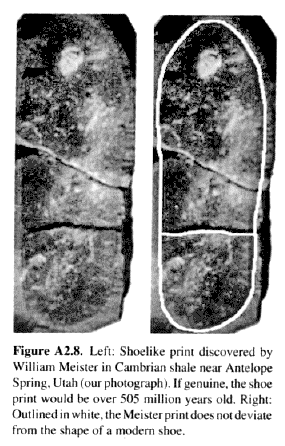
Scientists who were made aware of the Meister discovery were
sometimes contemptuous in their dismissals.
This is evident from
private correspondence supplied to us by George F. Howe of Los
Angeles Baptist College, who requested that we quote from it
anonymously. A geologist from Brigham Young University, quite
familiar with the Antelope Springs region, wrote in 1981 that the
track represented "an oddity of weathering which uninformed people
mistakenly interpret for fossil forms."
A professor of evolutionary biology from a Michigan university
stated, when asked about the Meister print:
"I am not familiar with
the trilobite case. . . . but I would be greatly surprised if this
isn't another case of fabrication or willful misrepresentation.
There is not one case where a juxtaposition of this type has ever
been confirmed. So far the fossil record is one of the best tests
that evolution has occurred. I put the creationists and those that
believe in a flat earth in the same category.
They simply do not
want to believe in facts and hard evidence. There is not much you
can do with such people. . . . Nothing has emerged in recent years
to refute the fact that evolution has, and continues to occur,
irrespective of what the self-proclaimed 'scientific' creationists
claim. The ability of individuals in our society to be duped and
brainwashed, either intentionally or unknowingly, by our mass media
and certain leaders never ceases to amaze me."
The evolutionary biologist admitted he had not familiarized himself
with the "facts and hard evidence" relating to the Meister sandal
print before passing judgment. He was thus guilty of the same sin he
accused the creationists of committing. We do not necessarily accept
the Meister print as genuine, but we believe it should be evaluated
on its own merits, rather than on the basis of inflexible
preconceptions.
William Lee Stokes, a biologist and geologist at the University of
Utah, examined the Meister print shortly after it was discovered.
Stokes stated:
"After seeing the specimen I explained to Mr. Meister
why I could not accept it as a footprint and why geologists in
general would not accept it. At the very least, we would expect a
true footprint to be one of a sequence showing right and left prints
somewhat evenly spaced, of the same size and progressing regularly
in one direction. . . . It is most significant that no other
matching prints were obtained. I know of no instance where a
solitary one-of-a-kind impression has been accepted and reported in
a scientific journal as a genuine footprint no matter how
well-preserved it might be."
But in an article that appeared in
Scientific American in 1969, H. de Lumley reported a single
humanlike footprint from the Middle Pleistocene habitation site at
Terra Amata in southern France.
Stokes further stated:
"A true footprint should also show
displacement or squeezing aside of the soft material into which the
foot was pressed. . . . From my examination of this specimen I can
say that there is no evidence of squeezing or pushing aside of the
matrix."
In 1984, one of us (Thompson) visited Meister in Utah. Close
inspection of the print revealed no obvious reason why it could not
be accepted as genuine. Concerning squeezing aside of the matrix,
much depends on the consistency of the matrix and the nature of the
object making the imprint. The rounded contours of a bare foot
result in more pushing aside of the matrix than the sharp edges of
the soles of footwear.
We have observed that shoes and sandals can
leave very sharp impressions in relatively compact, moist beach
sand, with very little sign of pushing aside of the matrix. Shale,
the rock in which the Meister print was made, is formed by the
consolidation of clay, mud, or silt. One could microscopically
examine the grain structure of the shale within the region of the
print in order to determine whether or not there is any evidence
suggesting that the print was not caused by pressure from above.
Stokes concluded that the Meister specimen was the result of
spalling, a natural fracturing of the rock, and stated that the
geology department of the University of Utah had in its collection
several products of spalling, some resembling footprints. One would
have to see these specimens to judge if they really resemble
footprints to the extent the Meister specimen does. The shape of the
Meister print, as shown by our visual inspection and computer
analysis, almost exactly matches that of a modern shoeprint.
Furthermore, spalling normally occurs on the surfaces of rocks. The
Meister print, however, was found in the interior of a block of
shale that was split. Significantly, the shale in the region of the
print is of a rougher texture than the shale on the other parts of
the split block's surface. This suggests that the rock split where
it did not accidentally but because of a line of weakness along the
boundary of the two textures. One could, therefore, propose that an
ancient shoe caused this shoe-shaped area of weakness.
Alternatively, the area of weakness might have resulted from some
other unknown cause, in which case the shoe-like shape is entirely
coincidental. This would be a rather remarkable freak of nature, for
the print does not even slightly depart from the shape of a genuine
shoe.
The Meister print, as evidence for a human presence in the distant
past, is ambiguous. Some scientists have dismissed the print after
only cursory examination. Others have rejected it sight unseen,
simply because its Cambrian age puts it outside the realm of what
might be expected according to evolutionary theory.
We suggest,
however, that the resources of empirical investigation have not yet
been exhausted and that the Meister print is worthy of further
research.
GROOVED SPHERE FROM SOUTH AFRICA
Over the past several decades, South African miners have found
hundreds of metallic spheres, at least one of which has three
parallel grooves running around its equator. According to an article
by J. Jimison, the spheres are of two types—"one of solid bluish
metal with white flecks, and another which is a hollow ball filled
with a white spongy center."
Roelf Marx, curator of the museum of Klerksdorp, South Africa, where some of the spheres are housed,
said:
"The spheres are a complete mystery. They look man-made, yet
at the time in Earth's history when they came to rest in this rock
no intelligent life existed. They're nothing like I have ever seen
before."
We wrote to Roelf Marx for further information about the spheres. He
replied in a letter dated September 12, 1984:
"There is nothing
scientific published about the globes, but the facts are: They are
found in pyrophyllite, which is mined near the little town of
Ottosdal in the Western Transvaal. This pyrophyllite is a quite soft
secondary mineral with a count of only 3 on the Mohs scale and was
formed by sedimentation about 2.8 billion years ago. On the other
hand the globes, which have a fibrous structure on the inside with a
shell around it, are very hard and cannot be scratched, even by
steel."
The Mohs scale of hardness is named after
Friedrich Mohs,
who chose ten minerals as references points for comparative
hardness, with talc the softest (1) and diamond the hardest (10).
In his letter to us, Marx said that A. Bisschoff, a professor of
geology at the University of Potchefstroom, told him that the
spheres were "limonite concretions." Limonite is a kind of iron ore.
A concretion is a compact, rounded rock mass formed by localized
cementation around a nucleus.
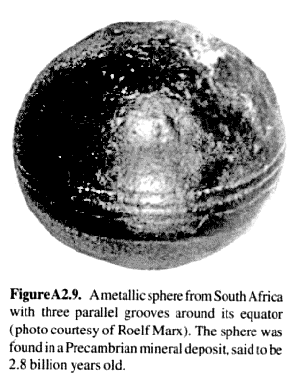
Grooved Sphere from South Africa
One problem with the hypothesis that the objects are limonite
concretions concerns their hardness. As noted above, the metallic
spheres cannot be scratched with a steel point, indicating they are
extremely hard. But standard references on minerals state that
limonite registers only 4 to 5.5 on the Mohs scale, indicating a
relatively low degree of hardness.
Furthermore, limonite concretions
usually occur in groups, like masses of soap bubbles stuck together.
They do not, it seems, normally appear isolated and perfectly round,
as is the case with the objects in question. Neither do they
normally appear with parallel grooves encircling them.
For the purposes of this study, it is the sphere with three parallel
grooves around its equator that most concerns us. Even if it is
conceded that the sphere itself is a limonite concretion, one still
must account for the three parallel grooves.
In the absence of a
satisfactory natural explanation, the evidence is somewhat
mysterious, leaving open the possibility that the South African
grooved sphere—found in a mineral deposit 2.8 billion years old—was
made by an intelligent being.
ANOMALOUS HUMAN SKELETAL REMAINS
In the nineteenth and early twentieth centuries scientists found
numerous stone implements and other artifacts in extremely old
formations. They also discovered anatomically modern human skeletal
remains in similarly ancient geological contexts.
Although these human bones originally attracted considerable
attention, they are now practically unknown.
Most current literature
gives one the impression that after the discovery of the first
Neanderthal in the 1850s no significant skeletal finds were made
until the discovery of Java man in the 1890s.
TRENTON FEMUR
On December 1, 1899, Ernest Volk, a collector working for the
Peabody Museum of American Archaeology and Ethnology at Harvard
University, discovered a human femur in a fresh railroad cut south
of Hancock Avenue within the city limits of Trenton, New Jersey. The
femur was found lying on a small ledge, 91 inches beneath the
surface. Volk stated:
"About four inches over or above the bone. . .
. was a place about the length of the bone where it evidently had
fallen out of."
The human femur was photographed by Volk, who
declared that the overlying strata immediately above and for some
distance on either side of the find were undisturbed. Volk said that
the femur was thoroughly fossilized. Two human skull fragments were
taken from the same layer that yielded the femur.
In a letter dated July 30, 1987, Ron Witte of the New Jersey
Geological Survey told us that the stratum containing the Trenton
femur and skull fragments is from the Sangamon interglacial and is
about 107,000 years old.
According to standard ideas, human beings
of modern type arose in southern Africa about 100,000 years ago and
migrated to America at most 30,000 years ago.
Back
to Contents
|








